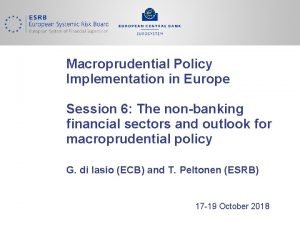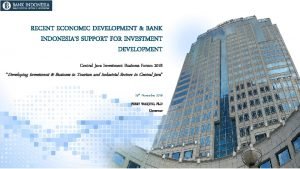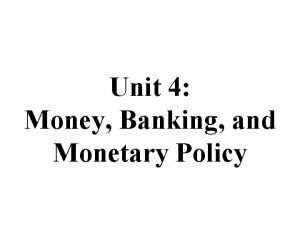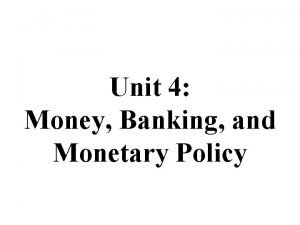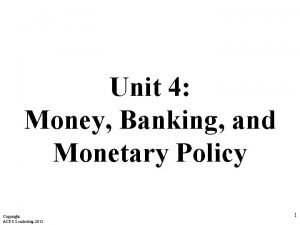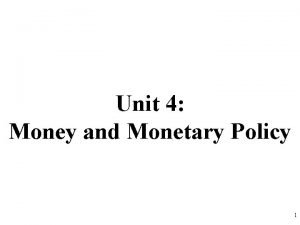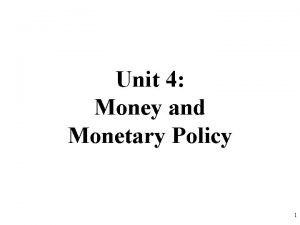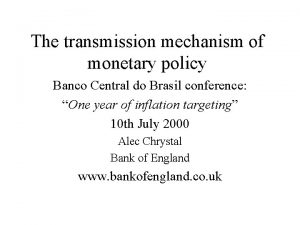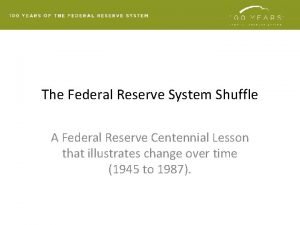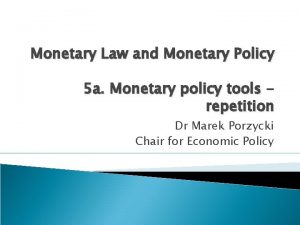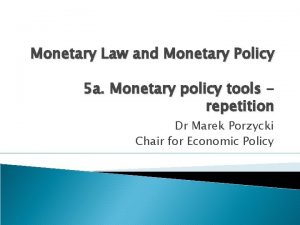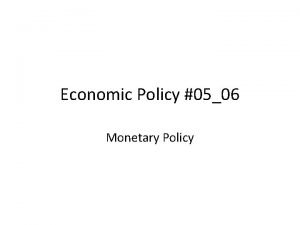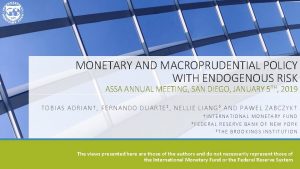Comments on Macroprudential and Monetary Policy LoanLevel Evidence













- Slides: 13

Comments on: Macroprudential and Monetary Policy: Loan-Level Evidence from Reserve Requirements by Cecilia Dassatti Camors and José-Luis Peydro Stijn Claessens NBER-CBRT Conference on Monetary Policy and Financial Stability Istanbul, June 13 -15, 2014

Sorry!

Question and Answer • What are effects of reserve requirements (RR)? – Largely seen as monetary policy, some macroprudential – Does it matter for reducing boom and bust patterns? • Investigated using detailed data for Uruguay • Empirical evidence suggest (ambiguous) results – Credit declines on aggregate – But more risky firms get more credit – Larger banks less affected • May thus be financial stability tradeoffs using RR – Less credit due to RR may not mean less system risks – Still, RR may be beneficial as macroeconomic tool

Praise • Surely a worthwhile topic – Much interest in macro-prudential policies, some in RR – But investigated so far largely with aggregate data – Very little ability to control, including for endogeneity of macro-prudential policies – Thus hard to know tradeoffs between less credit, reduced risk taking, etc. and real economic costs • Here, using micro data, can avoid many such problems – Very detailed, firm-banks matched data – Clean, using diff in diff tests around/of single event – Little/no endogeneity, omitted variables, etc. – Investigates intensive and extensive margins

Main Comments • Caveat: Much due to reading version where I inserted my interpretations of some of the results! • Be more careful on the mechanisms/model • Not clear is price or quantities that do adjustment • Show more (supportive) evidence of trade-offs • Less credit, how much less growth? • More risk taking, how much more (systemic) risks? • Investigate also prices, not just quantities • Economic interpretations and lessons • Think harder what it all means • Refer to broader literatures on RR, risk taking

Model (implicit) • Not so much about Modigliani Miller proposition! • Raising RR (unremunerated) means a tax on FI – Tax on financial intermediation, lower deposit and/or raise lending rate. Can reduce quantity of credit demanded – But higher costs also increase incentives on part of banks and borrowers to take more risks per unit borrowed – Tradeoff affected by capital adequacy/franchise value, etc. • Lower capitalized banks take possibly less risks • RR also affects quantity of funding (esp. if differential) – Less whole-sale/foreign funding, thus more stable, may affect risky (short-term) lending more (Adrian-Shin, Turkey) • Price and quantity channels can thus both operate

A “Better ” Model? • Combination of risk taking for financial institutions with borrower moral hazard, agency etc. – M&M neither applies to banks or borrowers! – For example, using the competition literature: • Greater competition, lower spread less risk taking by firms, more stable financial system • But also greater competition, lower profitability more risk taking by financial institutions, less stable system • Both price and quantity adjustments, not in M&M ways – Here also complex and state dependent interactions • Possibly less credit, but more to risky firms • State of banking system and cycle important to consider • And degree of (deposit) competition, domestic, international

From: “Reserve requirements in the brave new macroprudential world” • While an increase in capital requirements decreases the riskiness of the banks’ loan portfolio, an increase in RR or taxes on credit is likely to increase it. • How does this happen? The reason is that an increase in the banks’ external cost of funding, driven by an increase in RR, affects the banks’ bottom line only in those states of the world in which the bank actually repays its debt, that is, when it does not fail. • This means that higher RR reduce the banks’ returns in the case of success and thus make banks less willing to put an additional effort to improve the quality of their portfolio. • In other words, higher RR tend to exacerbate moral hazard and to induce banks to behave in a less prudent way.

Empirics comments • Very clean identification using diff in diff. – Hard to criticize methodology! Yet: – Impact seem relatively small (was a large increase in RR • Miss economic importance of factors, notably banks’ – Role of bank capital. Cannot infer, but economic importance appears small (? ) Avoidance? – Other bank effects. Is it clientele (thus SMEs hurt more)? – Differential importance by funding source affected by RR (FX vs. LC, short-term vs. long-term)? • Tell more on firms and explain impact for rating 1 & 5 – Distribution across size, risks, etc. categories, # switch, end – Rating 5 (default) see most impact of RR: still alive?

Empirics (more) Prices & Intensive vs. extensive margins • Also investigate prices (interest rates) – Do you observe rates and do they (differentially) adjust? • Hard to do extensive in short window. Still find different switches (yes/no renewed; yes/no switch): – How about compare “end and not switch” w/ others? • Using bank variables takes some effects away (vs. FE). Also large banks w/ branches less new – Interpretation? (Why these banks need to do so? ) • Overall more likely new, yet more risky firms; less likely new (and more likely to end) – Interpretation? In extensive margin good screening, but in intensive margin is it relationships or Zombie firms?

Other comments • Placebo tests – Do better with controls! What does this mean? • How do larger banks circumvent? – Is this access to interbank markets, (preferential) bonds, CP, etc. ? Related to TBTF? Can you explain? • Why need to do a survey of firms for ex-post? – Can revisit access to finance using credit registry? • What was exact reason (and day) of RR? – Matters for interpretation (and residual endogeneity, Vegh. . ) – Where U was in (interest rate) financial, capital flow cycle? • RR have monetary policy effects – Show what happened to interest rate/monetary policy • But not “to reduce money in circulation”

From: “Reserve requirements in the brave new macroprudential world” • Cyclical use of taxes to dampen the credit cycle may exacerbate the tensions between micro and macro prudential policies when the cycle is driven by interest rates. – When interest rates are low, banks already have an incentive to move to riskier projects and incentives are strengthened if liabilities are heavily taxed. – When, instead, the cycle is driven by a great abundance of good projects, banks tend to be more prudent and the adverse effect of RR (or other form of “taxes”) on banks’ incentives is partially offset by the prudent behavior fostered by the stronger demand for credit.

Literature review • Selective (not just w. r. t. IMF • Add risk taking, also competition papers (large • Add more RR (macroeconomic) literature – Cordella, Vegh etc. shows that RR have some macro-prudential benefits, especially for “fear of free falling” countries that cannot lower rate • Better institutional environment may reduce use of RR – But they also highlight conflicts micro-prudential and macro-prudential of RR • Mix of policies needed/likely best. Could be here too
 Macroprudential policy
Macroprudential policy Macroprudential policy
Macroprudential policy Jisdor fixing
Jisdor fixing Unit 4 money banking and monetary policy
Unit 4 money banking and monetary policy Unit 4 money banking and monetary policy
Unit 4 money banking and monetary policy Lesson 2 activity 45 macroeconomics
Lesson 2 activity 45 macroeconomics Unit 4 money and monetary policy
Unit 4 money and monetary policy Unit 4 money and monetary policy
Unit 4 money and monetary policy Unit 4 money and monetary policy
Unit 4 money and monetary policy Transmission of monetary policy
Transmission of monetary policy Lesson quiz 16-1 monetary policy
Lesson quiz 16-1 monetary policy What are the objectives of monetary policy
What are the objectives of monetary policy What is monetary policy
What is monetary policy Monetary policy types
Monetary policy types

